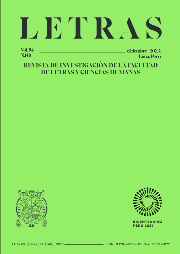Two Factors That Set the Difference between "El. Novela", by Mercedes Pinto, and "El" a Film by Luis Bunuel
Abstract
The differences between Él (1952), a film by Luis Buñuel, and the novel Él, which the Canarian author Mercedes Pinto published in 1926, can be studied based on the problems that every adaptation poses: “difference in languages”, “fidelity”, talent, needs expressions of the filmmaker, among other approaches. Without ignoring its validity, this paper is based on the premise that the inscription of Él as an autobiographical novel, as well as its feminine/feminist approach and its willingness to denounce domestic violence against women, and its goal of vindicating the divorce are the factors that make the radical difference with the film. Thus, Buñuel's film will be approached from its fictional record and its approach that favors the role of the male gaze unlike Pinto’s novel. From there, the feminine/feminist perspective, absent in the film, will be discussed, from the notions of “feminine writing” and “women’s literature” raised by Nelly Richard (1994), in relation to the so-called “Tretas del débil” studied by Josefina Ludmer (2017 [1985]) that account for the precarious place that society grants to women and how this marginalization is expressed in writing.Downloads
Métricas alternativas
References
Alberca, M. (2005-2006). ¿Existe la autoficción hispanoamericana? Cuadernos del CILHA, 7/8, 5-17. https://bdigital.uncu.edu.ar/1095
Alberca, M. (2007). El pacto ambiguo. De la novela autobiográfica a la autoficción. Biblioteca Nueva.
Aumont, J., Bergala, A., Marie, M. y Vernet, M. (1985). Estética del cine. Espacio fílmico, montaje, narración, lenguaje. Paidós.
Bluestone, G. (1957). Novels into Film. University of California Press.
Buñuel, L. (2004 [1982]). Mi último suspiro. Random House, Mondadori.
Capurro, R. (2008). Una estrategia femenina ante la violencia doméstica. Ponencia presentada en las jornadas Presencia de Mercedes Pinto en Uruguay. Conmemorando el 125 aniversario del nacimiento de Mercedes Pinto. 12-13 de noviembre. Centro Cultural de España, Montevideo. https://doi.org/10.30920/letras.94.140.9
Casas, A. (2014). La autoficción en los estudios hispánicos: perspectivas actuales. En A. Casas (Ed.), El yo fabulado. Nuevas aproximaciones críticas a la autoficción (pp. 7-21). Iberoamericana, Vervuert.
Chatman, S. (1978). Story and Discourse. Narrative Structure in Fiction and Film. Cornell University Press.
Cummings, G. (2004). Él: de Mercedes Pinto a Luis Buñuel. Filología y Lingüística, XXX(I), 75-91. https://doi.org/10.15517/rfl.v30i1.4455
De la Colina, J. (1961). La agonía del amor romántico. Nuevo Cine, 4-5, 8.
De la Colina, J. y Pérez Turrent, T. (1986). Luis Buñuel: prohibido asomarse al interior. Joaquín Mortiz, Planeta.
Evans, P. W. (1998). Las películas de Buñuel. La subjetividad y el deseo. Paidós.
Fuentes, V. (2000). Los mundos de Buñuel. Ediciones Akal.
Gerber Weinserberg, D. (2016). Paranoia y surrealismo. Revista Psicoanalítica, 3, 14-18. https://doi.org/10.25009/psi.v3i0.2236
Giordano, A. (2008). El giro autobiográfico de la literatura argentina actual. Mansalva Colección Campo Real.
Heitz, F. (2011). De Ella a Él, caras y máscaras en la “novela” de Mercedes Pinto (1926) y en la película de Luis Buñuel. Arbor. Ciencia, Pensamiento y Cultura, 187(748), 371-381. https://doi.org/10.3989/arbor.2011.748n2015
Llarena, A. (2003). Yo soy la novela. Vida y obra de Mercedes Pinto. Cabildo de Gran Canaria.
Llarena, A. (2014). Enseñar la vida. Mercedes Pinto. Cuadernos del Ateneo, 32, 27-39.
Llarena, A. (2022). Las otras voces de la edad de plata: Mercedes Pinto y la mujer moderna. Lectora, 28, 133-151. https://doi.org/10.1344/Lectora2022.28.7
Ludmer, J. (2017 [1985]). Tretas del débil. En N. Prigorean y C. Díaz Orozco (Eds.), Representaciones, emergencias y resistencias de la crítica cultural: mujeres intelectuales en América Latina y el Caribe (pp. 245-251). Consejo Latinoamericano de Ciencias Sociales.
Monegal, A. (1993). Luis Buñuel de la literatura al cine: una poética del objeto. Anthropos.
Paranaguá, P. A. (2001). Él, estudio crítico. Paidós.
Pinto, M. (1989 [1926]). Él. Novela. Viceconsejería de Cultura y Deportes del Gobierno de Canarias.
Pinto, M. (2011 [1934]). Ella. Novela. Ediciones Escalera.
Richard, N. (1994). ¿Tiene sexo la escritura? Debate Feminista, 9, 127-139. https://doi.org/10.22201/cieg.2594066xe.1994.9.1755
Rodríguez Hage, T. (s/f ). Buñuel, Pinto y las fuentes del filme Él. Biblioteca Virtual Miguel de Cervantes. https://www.cervantesvirtual.com/
Rodríguez Martín, M. E. (2019). De la fidelidad al original a las narrativas transmedia: desarrollo y evolución de las teorías de adaptación. En G. Pollarolo (Eds.), Cine y Literatura: Nuevas aproximaciones a viejas polémicas (pp. 39-61). Pontificia Universidad Católica del Perú.
Ruffinelli, J. (2003). Francisco y Archibaldo: los santos perversos de Luis Buñuel. En Buñuel: el imaginario transcultural (pp. 131-144). University of Ottawa.
Sánchez Vidal, A. (1994). Luis Buñuel. Cátedra.
Schwarze, M. (1988). Luis Buñuel. Plaza y Janés.
Stam, R. (2000). Beyond Fidelity: “The Dialogics of Adaptation”. En J. Naremore (Ed.), Film Adaptation (pp. 54-76). Rutgers University Press.
Wolf, S. (2001). Cine / Literatura. Ritos de pasaje. Paidós.
Copyright (c) 2023 Letras (Lima)

This work is licensed under a Creative Commons Attribution 4.0 International License.
Este obra está bajo una licencia de Creative Commons Reconocimiento 4.0 Internacional



















